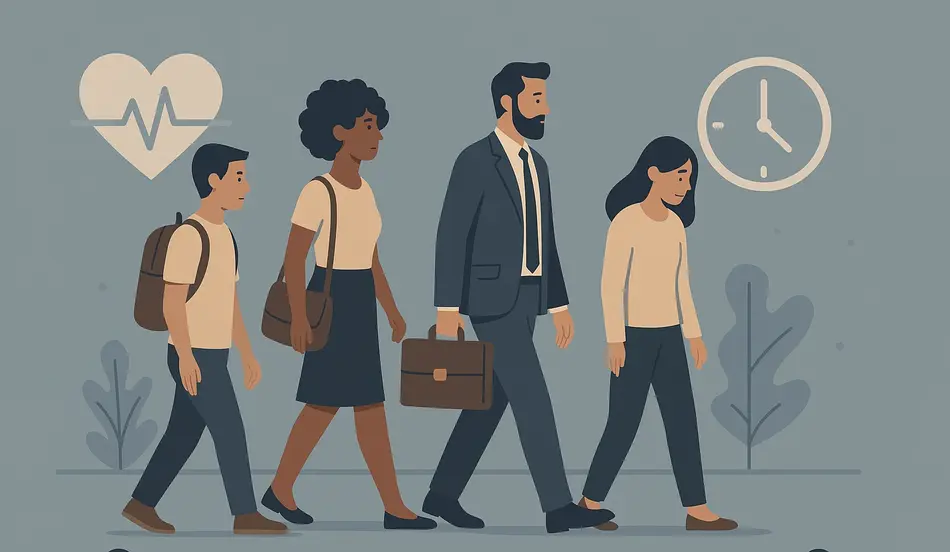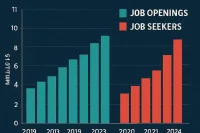Millennials dying younger represents a shocking reversal of decades of progress in human health and lifespans. After weathering financial crashes, political dysfunction, and environmental challenges, this generation now faces an unprecedented mortality crisis that has seen death rates among young adults spike by more than 20% in just four years.
Unlike previous generations, millennials in the US are experiencing mortality rates that are nearly 70% higher than experts expected, with tens of thousands of lives cut short. This crisis extends far beyond the pandemic, with death rates among 25-44 year olds surging since 2012 and continuing to rise even after COVID-19 mortality decreased.
What Makes Millennials Dying Younger Different from Previous Generations
The millennial mortality crisis differs from previous generational health challenges through its unprecedented scope and the unique combination of factors driving early deaths. Unlike past generations that faced specific health threats, millennials are confronting multiple simultaneous crises that compound each other.
The crisis is particularly severe in the United States, where 62% of deaths in the 25-44 age group wouldn’t have happened in peer nations. While there has been a small rise in young adult deaths worldwide, nowhere is the surge as extreme as in the United States, highlighting systemic issues specific to American society.
The combination of economic instability, mental health struggles, social isolation, and substance abuse creates a perfect storm that is literally killing a generation before their time.
The Opioid Crisis and Drug Overdose Epidemic
Drug overdoses are the number one cause of excess deaths among millennials, with opioid-related deaths increasing by 500% from 1999 to 2017. The crisis began in the late 1990s when prescription opioids became widely available, with most patients not warned about the brutal side effects and massive addiction risk.
When regulatory services caught up and doctors stopped prescribing opioids for every minor injury, millions were already addicted. They either obtained drugs illegally or moved to heroin, with nearly 80% of heroin users reporting they started with prescription painkillers.
Fentanyl has now overtaken heroin and prescription painkillers as the leading cause of opioid deaths, with 90% of opioid-related overdose deaths involving fentanyl by 2022. Many people who died from fentanyl didn’t even take it on purpose, as drugs like cocaine are often laced with fentanyl, resulting in accidental overdoses.
Economic Stress and Mental Health Struggles
Millennials entered the workforce during the Great Recession, facing an economic landscape that made career advancement more like a “frogger-style race” than a traditional ladder. The average millennial carries more than $87,000 in debt, with skyrocketing prices creating constant financial stress.
A full 20% of US adults have a mental health diagnosis like anxiety or depression, one of the highest rates among wealthy countries. Among US adults in emotional distress, about half blame social and economic worries, a much higher share than in other countries.
Between 2014 and 2017, depression and hyperactivity disorders like anxiety and ADHD jumped 30% among millennials. Despite being the most likely to seek professional help, they’re also the most likely to have access or affordability issues, with two-thirds of Americans with diagnosed mental health conditions unable to get treatment even with health insurance.
Supporting Workers in Stressful Times
Economic pressure and mental health challenges are reshaping the modern workforce. Employers can make a difference by offering supportive environments, stability, and meaningful opportunities. Post your job on WhatJobs today and connect with candidates seeking not just employment, but workplaces that value wellbeing and resilience.
Post a Job Free for 30 Days →The Loneliness Epidemic and Social Isolation
The US Surgeon General declared loneliness an epidemic in 2023, warning that it impacts mortality as much as smoking 15 cigarettes per day. Millennials are particularly affected, with 30% saying they often or always feel lonely, compared to 20% of Gen X and 15% of baby boomers.
An astonishing 22% of millennials report having no friends, compared to 16% of Gen Xers and 9% of baby boomers. Scientists found that social isolation causes a 32% higher risk of early death, partly because it causes chronic stress that inflames the body and increases the risk of cancer and heart attacks.
The combination of individualistic culture, low supply of mental health workers, and practical barriers to treatment creates a perfect storm for social isolation and its deadly consequences.
Alcohol-Related Deaths and Substance Abuse
Alcohol-related deaths in the US increased by 69% among millennials from 2007 to 2017, despite overall alcohol consumption dropping. The explanation is that moderate drinkers are giving up alcohol, while heavy drinkers continue or increase their consumption under social and financial pressure.
The story of Britney Rose Howlet exemplifies the crisis – a millennial suffering from student debt and prolonged unemployment who developed an alcohol disorder and died of fatal pancreatitis at age 26. There are entire Facebook groups of families honoring millennial relatives who died of diseases like liver failure and pancreatitis before age 40.
The causes of alcoholism and drug addiction are similar: economic instability, mental health struggles, and social isolation all drive people toward self-medication, and millennials are dealing with all of these factors simultaneously.
Chronic Disease and Lifestyle Factors
Millennials are experiencing higher rates of chronic disease than Gen X had at the same age, with health already declining by age 27. Heart failure-related mortality has increased by 96% in people under 45 between 2012 and 2021, while stroke risk has risen with each new generation.
Cancer is rising fastest in people in their 30s, showing up more aggressively and at later stages. Research found that under-55s are 60% more likely to be diagnosed late compared to other adults, partly because doctors don’t immediately think of cancer when young people present with mild symptoms.
Millennials are twice as likely to develop colon cancer as baby boomers, with gastrointestinal cancers having the fastest-growing incidence among early-onset cancers. The combination of obesity, stress, loneliness, and environmental exposures is creating a perfect storm for early-onset cancer.
The Role of Healthcare Access and Prevention
Only 67% of millennials have a primary care doctor compared to 84% of baby boomers, making preventive care nearly impossible. Adults aged 18-44 average just 173 doctor visits per 100 people, compared to 302 for those 45-64 and 550 for seniors over 65.
This means the average millennial sees a doctor once or twice a year, with some not seeing them at all. Without regular checkups, serious health conditions go undetected until it’s too late, contributing to the high rates of late-stage cancer diagnoses and preventable deaths.
The lack of healthcare access is compounded by economic factors, with 10% of American adults with mental illness lacking health insurance, and even those with insurance often unable to access treatment due to cost or availability issues.
Frequently Asked Questions
What does millennials dying younger mean for society and future generations?
Millennials dying younger represents a shocking reversal of health progress, with death rates up 20% in 4 years due to opioid crisis, mental health struggles, economic stress, and social isolation, potentially making them the first generation to live shorter lives than their parents.
How does the millennials dying younger crisis differ from previous generational health challenges?
Millennials dying younger crisis differs from past challenges by combining multiple simultaneous threats including opioid addiction, mental health struggles, economic instability, social isolation, and chronic disease, creating a perfect storm that is unique to this generation.
What are the main causes of millennials dying younger at such alarming rates?
Millennials dying younger is primarily caused by drug overdoses (especially opioids and fentanyl), alcohol-related deaths, mental health struggles, social isolation, chronic disease, and lack of healthcare access, all compounded by economic stress and social factors.
How can society address the millennials dying younger mortality crisis?
Addressing millennials dying younger requires comprehensive solutions including better mental health access, substance abuse treatment, economic support, social connection programs, preventive healthcare, and addressing the root causes of inequality and social isolation.
A Real-World Example: Jessica’s Health Journey
Jessica Martinez, a 32-year-old marketing coordinator from Denver, exemplifies how millennials dying younger crisis affects real people. After years of struggling with student debt, job insecurity, and social isolation, Jessica found herself facing multiple health challenges that seemed to compound each other.
“I had been dealing with anxiety and depression for years, but I couldn’t afford therapy or regular doctor visits,” Jessica explains. “When I started having health problems in my late 20s, I was terrified because I knew I couldn’t afford to get sick, but I also couldn’t afford to get better.”
Jessica’s journey with the millennials dying younger crisis began when she started experiencing chronic pain and digestive issues. She was particularly concerned about the high rates of early-onset cancer and chronic disease among her peers, especially since she had limited access to preventive healthcare.
“The stress of constantly worrying about money and health was overwhelming,” Jessica says. “I found myself turning to alcohol to cope with the anxiety, which only made my health problems worse. It felt like I was caught in a cycle that was literally killing me.”
Within two years of recognizing her health crisis, Jessica had made significant changes to her lifestyle, including finding a community support group, improving her diet, and finding ways to access affordable healthcare. She also addressed her mental health issues and substance use problems.
“Millennials dying younger isn’t just a statistic – it’s a reality that many of us are living,” Jessica reflects. “The crisis taught me that I had to take control of my health and well-being, even when the system seemed stacked against me. It’s not easy, but it’s literally a matter of life and death.”




